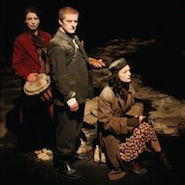Posted 15 July 2015
The Irish Dramatic Revival: the redefinition of Irish theatre and the birth of the Abbey
The Dramatic Revival was the story of the Abbey Theatre and the major playwrights who, through their revolutionary and innovative works, radically redefined Ireland’s cultural and even political landscapes.
A new book The Irish Dramatic Revival 1899-1939 published by Bloomsbury provides a fresh reassessment of the works, creative struggles and achievements of the artists – William Butler Yeats, Lady Gregory, John Millington Synge and Sean O’Casey – who defined this period of far-reaching artistic change and development.
The author of the work, Professor Anthony Roche from the UCD School of English, Drama and Film has published widely on Irish drama and theatre from the late 19th century to the present.
From the very beginning, the Abbey affirmed not just that it was a distinct break from the more commercial fare widely on offer in the capital city’s other theatres, but that the works “were an image of the country as a whole”.
This new book provides contextualised readings of the plays written by the movement’s most prominent playwrights, as well as those of W.B. Yeats, who is a consistent presence as “his influence continues beyond Beckett’s dramatic breakthrough in the 1950s right up to the present”.
“The Irish Dramatic Revival and Yeats as co-founder, poet and playwright have proved inspiration and example for other countries worldwide emerging from colonisation into an exploration and development of their own cultural identity.”
A common thread that emerges from this new appraisal of the Dramatic Revival is that despite Yeats’ attempt to set the agenda for the creative output at the Abbey all of the other major Irish playwrights, O’Casey, Synge and Gregory, challenged his wishes by producing innovative and experimental works.
“What they challenged most was Yeats’ selfish desire to keep all theatrical experimentation to himself. All of the Abbey playwrights … spoke in favour of experiment in the theatre and made a point of never repeating themselves.”
Professor Roche explores Synge's experimentation in the creation of a new “revolutionary” national drama that culminated in the Revival’s “most controversial and ultimately the most influential play”, The Playboy of the Western World (1907).
Synge’s works drew on traditional and native sources, but more importantly helped to develop a prophetic form of theatre.
Plays like The Well of the Saints (1905) contained “brilliant modernist innovation” and employed structural repetition and variation, which profoundly influenced successive generations of modern playwrights including – most notably in an Irish context – Samuel Beckett.
Lady Gregory is considered not only as a co-founder and director of the Abbey Theatre, but also as a significant playwright in her own right, who by “having her plays produced regularly on the Abbey stage created a powerful precedent and paved the way for other Irish women playwrights to follow”.
A chapter on Shaw outlines his “considerable” intervention in the revival. Shaw’s play John Bull’s Other Island (1904), which was “uncongenial to the whole spirit of the neo-Gaelic movement”, and mocked many Revivalist themes, was originally intended to be staged for the opening of the Abbey in 1904.
The author imagines how the initial programme of the Abbey might have looked in 1904 if Shaw’s play had been staged alongside Yeats’ On Baile’s Strand, Lady Gregory’s Spreading the News and Synge’s The Well of The Saints.
He concludes that “These three Irish and Abbey Theatre plays mutually illuminate and refine each other, and indicate their shared characteristics more fully when the missing Shaw is restored [to the Abbey programme]”.
O'Casey's four groundbreaking Dublin plays, The Shadow of the Gunman (1923), Juno and The Paycock (1924), The Plough and the Stars (1926), and The Silver Tassie (1928) also receive detailed consideration.
Professor Roche describes these O’Casey plays, which were set during the key historical events of the period – the Easter Rising, the War of Independence, the Civil War and the First World war – as a “political intervention and have had a critical influence on how those historic events have come to be interpreted”.
He also traces the development of the new Irish modernism that followed in the 1930s, a decade which witnessed the founding of the Gate Theatre in Dublin.
In addition, the new work features interviews and essays by leading theatre scholars and contemporary practitioners Paige Reynolds, P.J. Mathews and Conor McPherson who provide further critical perspectives on this period of radical development in modern Irish theatre.
Professor Roche presented a copy of The Irish Dramatic Revival 1899-1939 published by Bloomsbury to the President of Ireland, Michael D Higgins at a recent visit to Áras an Uachtaráin.
(Produced by UCD University Relations)

